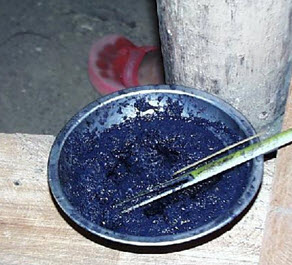Mehndi MadnessTM Blog
 Krysteen
KrysteenHere at Mehndi Madness, we offer henna based mehndi as well as jagua based mehndi. Some (or most) of our followers might ask, What is jagua? Well today is your lucky day, because we are about to tell you!
 Jagua, like henna, temporarily stains the skin and is all natural. The jagua “ink” comes from an extract of the fruit of the jagua (or, Genipa Americana) tree. This tropical tree can be found in South America and some parts of Latin America. Typically, jagua is used on the surface of the skin, however, tribes like the Matses Indians of Peru also insert it underneath the surface of the skin in order to make permanent markings.
Jagua, like henna, temporarily stains the skin and is all natural. The jagua “ink” comes from an extract of the fruit of the jagua (or, Genipa Americana) tree. This tropical tree can be found in South America and some parts of Latin America. Typically, jagua is used on the surface of the skin, however, tribes like the Matses Indians of Peru also insert it underneath the surface of the skin in order to make permanent markings.
Jagua also has many medicinal properties. It can be used on the skin to repel insects, aid digestion, kills bacteria, and expels worms in the body. A syrup, or infused water is made by the Amerindians and consumed in order to treat asthma, and reduce inflammations in the respiratory system. The pulp of the fruit is used as a topical anesthetic and the scraped fruit can be applied to the skin to reduce itching. In El Salvador, the fruit is eaten to treat jaundice. In Puerto Rico a cold remedy can be made with fermented jagua fruit, water, and flavoring.
 In Guyana (neighboring country to Venezuela), the ripe fruit is mainly used as fish bait. The fallen fruit is a favorite snack to many wild animals in the regions where the tree grows naturally. The jagua fruit can also be enjoyed as a sweet treat. Puerto Ricans enjoy the fruit in homemade lemonade, The fruit juice can also be concentrated and used as shaved ice syrup by street vendors. In the Philippines the juice is used to make flavored sherbet, ice cream, jello and refreshing drinks. In rural Brazil, people make syrups, liqueur, wine, and a soft drink they call Genipapada.
In Guyana (neighboring country to Venezuela), the ripe fruit is mainly used as fish bait. The fallen fruit is a favorite snack to many wild animals in the regions where the tree grows naturally. The jagua fruit can also be enjoyed as a sweet treat. Puerto Ricans enjoy the fruit in homemade lemonade, The fruit juice can also be concentrated and used as shaved ice syrup by street vendors. In the Philippines the juice is used to make flavored sherbet, ice cream, jello and refreshing drinks. In rural Brazil, people make syrups, liqueur, wine, and a soft drink they call Genipapada.
Resources:
http://www.rain-tree.com/genipap.htm#.U1hg9nBiFuU
http://en.wikipedia.org/wiki/Jagua_Tattoo
